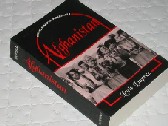
Learning: The Journey of a Lifetime
Journals as an Aid to Learning
Afghanistan
afghan1 |
An Example of a "Learning Process" Journal (using the 2 colored box format) |
September
5 , 2003 |
|
Book: Afghanistan by Louis Dupree Source: Oxford Pakistan Paperbacks. Oxford University Press, 1973. |
| I finally obtained this book yesterday. Gordon originally recommended it but it was out of print. I finally noticed from looking at the Oxford web site that it appeared to be reprinted. The university bookstore was able to order it, and there was a delay since they said it was coming from Pakistan. |
| Author: All I have to go on is my awareness that he spend much of his life in Afghanistan. Plus the fact that Oxford University Press has a great reputation. |
| All I have to go on is my awareness that he spend much of his life in Afghanistan. I believe his wife still lives there (or at least did until fairly recently). I want to pursue this by conducting some google searches using his name. |
| Let's begin by reviewing the Table of Contents.
There are 4 main sections:
|
| The four main sections provide a clear and concise summary, not only of the book, but of a structure for learning about any country or region. However even "The Present" section is now more properly the past. I will have to create a new section called "Since 1973". |
Section I The Land has 5 sub-sections:
|
The first thing that strikes me about the 5 sub-sections of Part I is the appropriateness of the topics for Afghanistan. I now have a framework for making notes about my learning of Afghanistan. This entire exercise from first opening the book, to creating a "Learning" entry in my Filemaker Pro database, to realizing that the web would be a better environment for the actual Learning file, to creating this page, has taken just under an hour. The next step is to read the Introduction (4 pages) and make a few notes. I am quite excited and optimistic about this venture. I also think it will serve as a good example for my Web-Based Learning course. But first I need to refill my coffee cup. |
Intoduction: Afghanistan Defined. Afghanistan has often been described as "Land of the Free", "Land of Rebels" or "Land of Insolence". "The insolence of the Afghan, however, is not the frustrated insolence of urbanized, dehumanized man in western society, but insolence without arrogence, ... the insolence of equality felt and practiced (with an occassional touch of superiority), the insolence of bravery past and bravery anticipated." [p. xvii] "For millennia, the land now called Afghanistan sat in the center of the action, the meeting place of four ecological and cultural areas: the Middle East, Central Asia, the Indian subcontinent, and even the Far East." [p. xvii] Here are a few important temporal markers:
|
This is not the first time I have read about the Afghan as a people with a strong sense of personal freedom. It is sobering to realize that this area is truly at the crossroads of civilization, today as well as in the past. It may be thought of as a microcosm of civilzation on the planet since the last century has also brought it into the sphere of both Western and Russian interests, and lately more globally with the rise of organized terrorism which uses this area as one of its "homes". I am totally unfamiliar with the Ghaznavid empire as well as the Durrani empire. I also do not have a clear idea of the actual dates of the Russian occupation or the Taliban control. I will see if I can find these dates in one of my timeline books... Done. This has been a promising beginning. I am pleased with my notes so far, and am looking forward to beginning the book. Summary: The land, the people, the past, the present. Ghaznavid and Durrani empires. 1979-89, 1996-2001. |
Reminder: each "Learning" session has a new web page.
Last Page |
||
E-mail: dale.burnett@uleth.ca |